| |
|
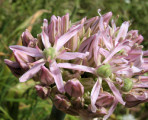 | |
| MaltaWildPlants.com by Stephen Mifsud |

|
| |
|
|
 |  |  |  |
| External Links: |
|
Symphyotrichum squamatum (Narrow-leaved Aster) |
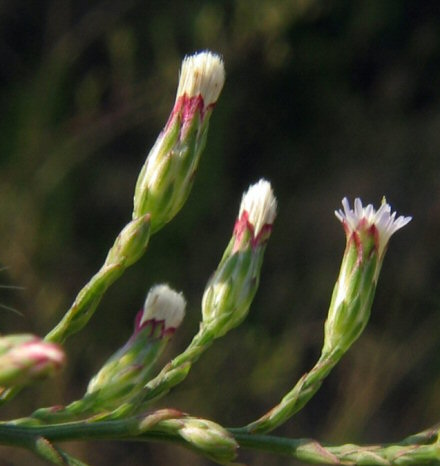
Symphyotrichum squamatum (ASTERACEAE.)
Images for this profile are taken from the Maltese Islands after year 2000. |
|
| Nomenclature |
Species name : | Symphyotrichum squamatum (Spreng.) G.L.Nesom | Authority : | Curt Polycarp Joachim Sprengel, Germany, (1766 - 1833 ;
Guy Nesom, North America | Synonyms :
(basionym or principal syn.) |
Symphyotrichum subulatum var. squamatum
(Spreng.) S.D.Sundb.
Synonym that was used for long in Malta:
Aster squamatus
Hieron.
Full list of synonyms :
[Euro+Med]
[PlantList]
[IPNI]
[POWO]
[Catalogue of Life]
[Worldplants.de]
|
Plant Family : | Asteraceae Bercht. & J.Presl (= Compositae )
(Daisy or Sunflower Family) | English name(s) : | Narrow-leaved Aster, Annual Saltmarsh Aster, Swamp Aster | Maltese name(s) : | Settembrina salvaġġa | Status for Malta : | Invasive Alien. Species that was introduced in Malta any time after year 1492 (Columbus' discovery of the New World),
and spreads rapidly to form large invasive populations to the detriment of native flora or ecosystems. | Name Derivation : |
Symphyotrichum: Derivation unknown. ( ); 2 = Meaning a star, describing the radiating petals of the flower heads of most members of this Genus = (Greek).
squamatum: 1 = Scaly, looks as if it is covered with scales. (Latin).
| Remarks : | |
|
| Morphology and structure |
PLANT STRUCTURE: |
Character | Growth Form | Branching | Surface |
Description | | | |
General
Picture |  | 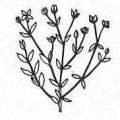 |  |
|
LEAVES: |
Character | Arrangement | Attachment | Venation |
Description | | | |
General
Picture |  |  |  |
| |
Character | Leaf Shape | Leaf Margin | Remarks |
Description | | | |
General
Picture |  |  |  |
|
FLOWERS: |
Character | Colour | Basic Flower Type | No. of Petals | No. of Sepals |
Description | White | | 30-40 | 18-24 Referring to the phyllaries of the involucre. |
General
Picture | | 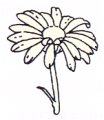 |  |  |
| |
Character | Inflorescence | Description | Ovary | Stamens |
Description | | The small flowers have white radiating petals (each about 2-3mm long) and a yellow center consisting of many tiny disc-florets. The corolla is enclosed in a structure called involucre which is made of 3 rows of small phyllaries where the upper layer have wine or red tips, hence forming a wine ring just under the base of the corolla. | | |
General
Picture |  |  |  | 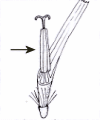 |
| |
Character | Scent | Average Flower Size | Pollen Colour | Other Notes |
Description | None | 5mm | Yellow | - |
|
SEEDS: |
Character | No. Per Fruit | Shape | Size | Colour |
Description | 50-100 | | 1-2mm | Light Brown |
General
Picture |  |  |  |  |
|
FRUIT AND OTHER BOTANICAL DATA: |
Character | Fruit Type | Colour of Fruit | Subterranean Parts | Other Notes |
Description | | Green (with a white brush border of pappii). | | Fruit-head It consists of a cylindrical green involucre with a white brush border atop, resembling a painter-brush. Often there is a red/wine ring at the tip of the involucre just under the brush border. |
General
Picture | 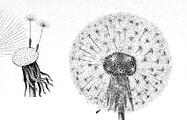 |  |  |  |
|
|
| Plant description and characters | |
Life Cycle: | Annual (sometimes biennial). |
Growth Form: | THEROPHYTE (annual plants, herbaceous) |
Habitat: | Valley beds, roadsides, disturbed wetlands, disturbed weedy places, also in urban areas and margins of irrigated fields |
Frequency: | Very Common |
Localities in Malta: | Common everywhere throughout the Maltese Islands. |
Plant Height: | 50-200cm. |
| Sep-Nov |
Protection in Malta: | Not legally protected till the last update of this website (2/Mar/2022) |
Red List 1989: | Not listed in the Red Data Book of the Maltese Islands |
Poison: | |
 This erect plant has an unbranched stem or with few short basal branches and so it is rather slender and do not occupy a large volume. However the upper flowering part, is well branched and sub-branched forming a panicle of flowers. The older plants will start flowering further down the stem. The length of the plant varies from 50cm to 200cm or more, depending on the light conditions and soil type. The stem of the species in Malta is reddish / wine, with unshallow grooves and glabrous (no bristles).
This erect plant has an unbranched stem or with few short basal branches and so it is rather slender and do not occupy a large volume. However the upper flowering part, is well branched and sub-branched forming a panicle of flowers. The older plants will start flowering further down the stem. The length of the plant varies from 50cm to 200cm or more, depending on the light conditions and soil type. The stem of the species in Malta is reddish / wine, with unshallow grooves and glabrous (no bristles).
The leaves are sessile, glabrous, have an entire outline and are generally linear / lanceolate. The lower leaves can grow up to 8cm long / 8 mm wide and usually clasp the stem by two small lobes (auricles); the cauline leaves are about 3cm long, 4mm wide and do not have auricles. All leaves are arranged alternately around the stem.
 The plant flowers with large, highly branched and sub-branched panicles, giving rise to numerous buds, flowers, fruit and seed-heads. Since the life span of the fruit is the longest one, there is normally more fruit in a given pannicle. The buds are small, green and tapering. The small flowers have white, short radiating petals and yellow centers and they are not so much conspicuous. There are about 32-40 slender petals - only about 1-2mm long, and the yellow center made up of of about 50 or more disc-florets. As in almost all Asteraceae species the disc florets are the true fertilising unit. Each floret can give rise to a single seed. The true sepals of the floret are the white bristles which later develop to the pappus of the seed.
The plant flowers with large, highly branched and sub-branched panicles, giving rise to numerous buds, flowers, fruit and seed-heads. Since the life span of the fruit is the longest one, there is normally more fruit in a given pannicle. The buds are small, green and tapering. The small flowers have white, short radiating petals and yellow centers and they are not so much conspicuous. There are about 32-40 slender petals - only about 1-2mm long, and the yellow center made up of of about 50 or more disc-florets. As in almost all Asteraceae species the disc florets are the true fertilising unit. Each floret can give rise to a single seed. The true sepals of the floret are the white bristles which later develop to the pappus of the seed.
The flower head is enclosed in a structure called involucre, made up of 3 layers of small phyllaries which resemble small leaflets or mistaken with sepals or bracts. The upper row of phyllaries are wine / purple tipped and makes an interesting purple ring just under the flower or the white brush of bristles in the fruit.
The fruit mainly consists of the involucre, unchanged in appearance from the flowering state and a brush of white bristles, being the pappii of the developing seeds inside. This makes the fruit appear like a small painter brush.
 When the seeds are ripe, the involucre opens up, exposing the seed-holding receptacle. The seeds or achenes are light brown in colour, flattened, 1mm long, with a pappus of numerous, dull white, simple, capillary-like bristles. The relatively large pappus and the its small light seed makes wind an excellent means of seed dispersal. The remaining drying involucre looks like a badminton shuttle.
When the seeds are ripe, the involucre opens up, exposing the seed-holding receptacle. The seeds or achenes are light brown in colour, flattened, 1mm long, with a pappus of numerous, dull white, simple, capillary-like bristles. The relatively large pappus and the its small light seed makes wind an excellent means of seed dispersal. The remaining drying involucre looks like a badminton shuttle.
|
|
| Information, uses and other details |
Origin and distribution
This plant origins from South / Central America and it is believed that it was introduced in Malta around the 1930s [E. Lanfranco]
Aster squamatus was this year (2006) found to be present in Millbay Docks, Plymouth, UK. The plant is there in some quantity indicating that it has been present, unrecorded, for some years. Until this year the plant was unknown in the UK. Sent through online form by [PP]
Medicinal Uses
Aster squamatus have a potential antidiarrhoeic effect to be confirmed by additional investigations in animals infected with enteropathogenic agents. [293].
Phytochemical screening suggested that stalks and roots contain steroids, terpenes, flavonoids,
phenols, substances that contain amino-groups, saponins and hydrolysable and condensed tannins. The
decoctions of leaves, stalks and roots indicated the presence of caffeic, cinnamic, and sinapic acids. All Aster
squamatus infusions significantly reduced gastrointestinal propulsion compared to control, whereas the
decoctions and ethanolic extracts did not alter this parameter. The effect of the infusions and the lack of
activity of the decoctions and ethanolic extracts may be linked to the presence of unstable or volatile constituents
in the plant. [294].
Personal Observations
Invasiveness in Malta:
This plant is an excellent example to show how invasive a plant can be, when given ideal environmental conditions. From research made by Guido and Edwin Lanranco, this plant was introduced sometime around the 1930s. Within less than 70 years the plant have overrun and overgrown throughout the whole Maltese islands (also to the islands of Gozo and Comino). Nowadays it is an abundant throughout the Maltese islands, in different habitats. Factors which are believed to have given the plant an advantage to populate in such a short time are:
- The Maltese climate is quite similar to that of the plant's origin (South / Central America), hence sunny, humid and warm.
- Each plant produces thousands of seeds which are effectively dispersed by wind.
- The seeds are so light that they can travel to few kms in fairly strong wind. For several months in Malta, there are windy days, especially in late spring, and most of Autumn. This plant usually flowers and seeds in Autumn - ideal time for wind dispersion.
- The plant is not too much fastidious. The seeds germinate easily and grows in many types of soil.
- The plant is described to be halophilic (salt tolerant) and this may be of an advantage to the plant growing on a small island surrounded by the Mediterranean sea water.
- The improved and deep rooting helps the plant to withstand and survive soil erosion. This was suggested by Tanti [295] who studied a case of soil erosion at Wied il-Qlejgha (Malta). He reported that most areas along the bed and sides of the valley are covered by opportunist plant species, such as the Aster squamatus.
The invasive problem of A. squamatus seems to be not only for Malta but in other places in the Mediterranean region for example in Abruzzi, Italy [296], the Adriatic coast (link to pdf document), Spain (link to pdf document), Canary Islands, (link to pdf document), etc. [SM]
Similar species
A. squamatus can be easily mistaken with a morphologically similar species - the Conyza canadensis. The tall erect stem, slender leaves, numerous flowers in panicles, and flower details are very similar to each other. The flowers and involucres are similar even in detail. However there are 3 main differences between the two plants which are described in the following table [SM]
| Characteristic |
A. squamatus |
C. canadensis |
| Stem and leaf hairs |
Glabrous |
Hairy |
| Stem Colour |
Wine or brownish |
Usually Green |
| Leaf shape and attachment |
Slender, linear, lower leaves have lobes clasping stem, always sessile |
Slender, oblanceolate, no lobes at base of leaf, lower leaves have a short stalk |
| Leaf outline |
All leaves are entire |
Mature leaves usually possess few small teeth like projections |
| Foliage |
Moderate number of leaves |
Numerous leaves |
Plant Height:
Many botanical books and sites describe this plant to be up to 100cm high, but I have seen A. squamatus up to 200cm high (Example) The height of the plant can very depending type of soil and light conditions. [SM]
|
|
| Links & Further literature
(0 papers) |

Google Web |

Google Images |

Google Scholar |

Research Gate |

Wikipedia |

JSTOR |

GBIF |

Med Checklist |

Cat. of Life |

EoL |

IPNI |

World Flora Online |

Plants of the World Online |

Vienna Virt. Herb. |

RBGE Herbarium |

KEW Herbarium |

MNHN |

Arkive |

IUCN |

CABI |
Kindly Email if there are papers and publications about local
studies or information about this species to be included in the list above.
|
| Photo Gallery (42 Images) | 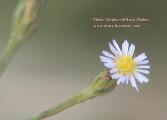 |
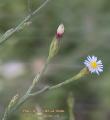 |
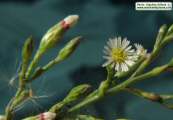 |
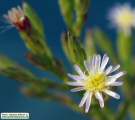 |
IMAGE: SYTSQ-01 Close up photo of flower. |
IMAGE: SYTSQ-02 Photo of typical flower and fruit of this species. |
IMAGE: SYTSQ-03 Photo of flower and fruit in situ. |
IMAGE: SYTSQ-04 Close up photo of flower consisting of slender tiny petals and a yellow centre. |
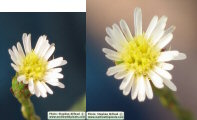 |
 |
 |
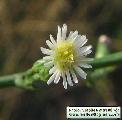 |
IMAGE: SYTSQ-05 Close up photo of 2 flowers. They consist of numerous ray florets with a white petal and a few yellow disk florets at the centre. |
IMAGE: SYTSQ-06 Close up photo of flower (lateral view). |
IMAGE: SYTSQ-07 Close up photo of flower. It measures about 5mm-6mm in diameter. |
IMAGE: SYTSQ-08 Close up photo of flower. |
 |
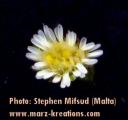 |
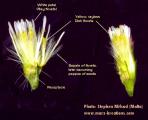 |
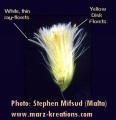 |
IMAGE: SYTSQ-09 Scanned image of flower against a dark background. The flower's diameter is about 5mm. |
IMAGE: SYTSQ-10 Scanned image of flower which basically consists of numerous (about 35) slender, white ray florets and central yellow disc florets. |
IMAGE: SYTSQ-11 Scanned image of a longitudinal section of a flower showing disc florets and their packed bristle-like sepals, which on maturation they become the pappus of the seeds. |
IMAGE: SYTSQ-12 Scanned image of a longitudinal section of a flower. |
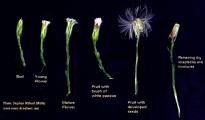 |
 |
 |
 |
IMAGE: SYTSQ-13 Scanned image against dark backround showing the development of the plant's reproductive organ starting from the bud, then the flower, the fruit and finally to the seeds. |
IMAGE: SYTSQ-14 Photo of numerous flowers and fruits on the plant. |
IMAGE: SYTSQ-15 Scanned image of a panicle (clusters of flowers). The extensive alternate branching and sub-branching may give rise up to 400 flowers. Each flower can produce about 50 seeds, so this plant produces large numbers of wind dispersed seeds. |
IMAGE: SYTSQ-16 Scanned image of a small panicle of flowers and fruit. |
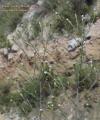 |
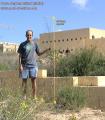 |
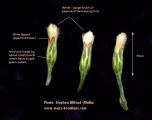 |
 |
IMAGE: SYTSQ-17 Photo of plant showing the upper panicles. |
IMAGE: SYTSQ-18 Photo of plant showing that it can grow more than the height of a man, often up to 220-250cm. |
IMAGE: SYTSQ-19 Scanned image of fruit which consists of an involucre, and a brush of pappus. |
IMAGE: SYTSQ-20 Scanned and enlarged image of fruit. |
 |
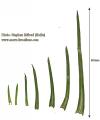 |
 |
 |
IMAGE: SYTSQ-21 Scanned image of a leaf stipule and its outgrowing new leaf branch (stem). The stipule is usually very large. |
IMAGE: SYTSQ-22 Scanned image of various leaves at different ages (young to old) the basal leaf is always the largest leaf. |
IMAGE: SYTSQ-23 Scanned and enlarged image of a typical leaf - long, slender linear / lanceolate shape. |
IMAGE: SYTSQ-24 Scanned image of leaf axil showing new growth of shoot from it (Axil = the angle between leaf and stem). |
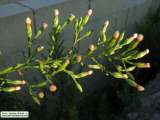 |
 |
 |
 |
IMAGE: SYTSQ-25 Close up photo of fruit showing the detail of the involucre. It consists of 3 rows of slender leaflet called phyllaries. |
IMAGE: SYTSQ-26 Close up photo of fruit showing the detail of the involucre. Note that the upper row of phyllaries have wine/red tips. |
IMAGE: SYTSQ-27 Close up photo of fruit showing in detail the involucre. Note that the lower phyllaries are green and have a lighter, pale green outline. |
IMAGE: SYTSQ-28 Close up photo of fruit. |
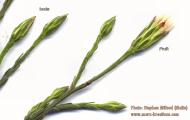 |
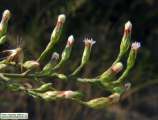 |
 |
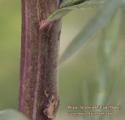 |
IMAGE: SYTSQ-29 Scanned image of several buds and a fruit. |
IMAGE: SYTSQ-30 Photo of a cluster of young fruit. They consist of the involucre which is green and red tipped, and brush border of pappi of the developing seeds inside. |
IMAGE: SYTSQ-31 Photo of the flowering part of plant. It is a multi-branching panicle containing buds, flowers, seed-heads and many fruit. |
IMAGE: SYTSQ-32 Close up photo of stem. In Malta species have reddish stem with no or very little hair or bristles. many authors describe the stem and leaves of the Annual Saltmarsh Aster, Narrow Leaved Aster as hairy and green. |
 |
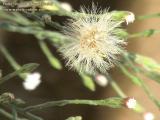 |
 |
 |
IMAGE: SYTSQ-33 Photo of seed heads. They are quite small, not very dense and off-white / beige in colour. |
IMAGE: SYTSQ-34 Photo of seed head with pappus bearing achenes. |
IMAGE: SYTSQ-35 Photo of seed head in situ. |
IMAGE: SYTSQ-36 Photo of seed head with some achenes dispersed, exposing the bare receptacle. |
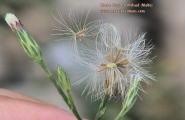 |
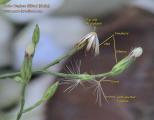 |
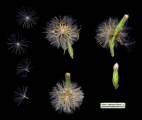 |
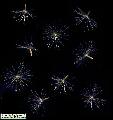 |
IMAGE: SYTSQ-37 Photo of seed head with some seeds dispersing away. |
IMAGE: SYTSQ-38 Photo of remaining of dry involucre and receptacle after seeds have been dispersed by wind. It resembles the shape of a badminton cock. |
IMAGE: SYTSQ-39 Scanned image of seed-heads consistin a ball of achenes with pappus sitting on a common receptacle. The seed-heads are beige in colour and about 12-15mm in diameter. Also included is a young fruit and few seeds. |
IMAGE: SYTSQ-40 Magnified scanned image of individual seeds, which have an unbeaked pappus with simple, unbranched, beige bristles. Pappus has an average diameter of 10mm. The seeds are small (1-2mm long) and light brown in colour. |
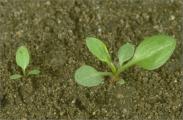 |
 |
| | IMAGE: SYTSQ-41 Photo of a young plant (seedling). |
IMAGE: SYTSQ-42 Magnified image of pollen under microscope. As in many species of the Asteraceae family, the shape of the pollen is that of a spiked ball. Taken from Flora apistica della Sicilia (by Prof. Nunzio Longhitano). |
IMAGE: SYTSQ-43 |
IMAGE: SYTSQ-44 |
|
| | |

